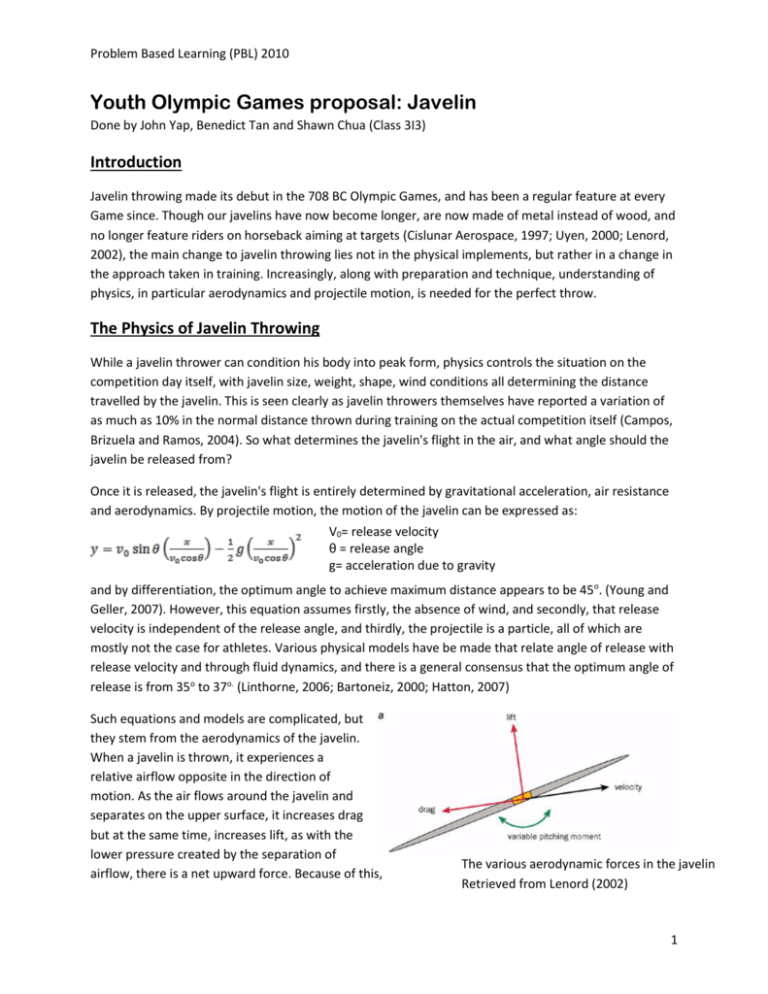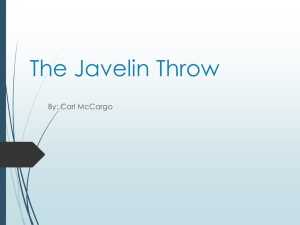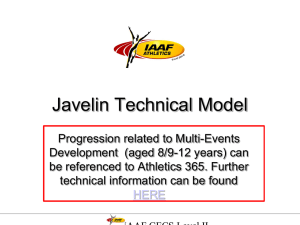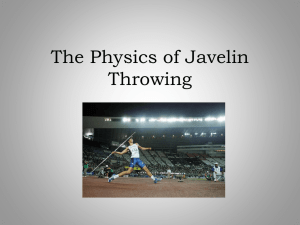
Problem Based Learning (PBL) 2010
Youth Olympic Games proposal: Javelin
Done by John Yap, Benedict Tan and Shawn Chua (Class 3I3)
Introduction
Javelin throwing made its debut in the 708 BC Olympic Games, and has been a regular feature at every
Game since. Though our javelins have now become longer, are now made of metal instead of wood, and
no longer feature riders on horseback aiming at targets (Cislunar Aerospace, 1997; Uyen, 2000; Lenord,
2002), the main change to javelin throwing lies not in the physical implements, but rather in a change in
the approach taken in training. Increasingly, along with preparation and technique, understanding of
physics, in particular aerodynamics and projectile motion, is needed for the perfect throw.
The Physics of Javelin Throwing
While a javelin thrower can condition his body into peak form, physics controls the situation on the
competition day itself, with javelin size, weight, shape, wind conditions all determining the distance
travelled by the javelin. This is seen clearly as javelin throwers themselves have reported a variation of
as much as 10% in the normal distance thrown during training on the actual competition itself (Campos,
Brizuela and Ramos, 2004). So what determines the javelin's flight in the air, and what angle should the
javelin be released from?
Once it is released, the javelin's flight is entirely determined by gravitational acceleration, air resistance
and aerodynamics. By projectile motion, the motion of the javelin can be expressed as:
V0= release velocity
θ = release angle
g= acceleration due to gravity
and by differentiation, the optimum angle to achieve maximum distance appears to be 45o. (Young and
Geller, 2007). However, this equation assumes firstly, the absence of wind, and secondly, that release
velocity is independent of the release angle, and thirdly, the projectile is a particle, all of which are
mostly not the case for athletes. Various physical models have be made that relate angle of release with
release velocity and through fluid dynamics, and there is a general consensus that the optimum angle of
release is from 35o to 37o. (Linthorne, 2006; Bartoneiz, 2000; Hatton, 2007)
Such equations and models are complicated, but
they stem from the aerodynamics of the javelin.
When a javelin is thrown, it experiences a
relative airflow opposite in the direction of
motion. As the air flows around the javelin and
separates on the upper surface, it increases drag
but at the same time, increases lift, as with the
lower pressure created by the separation of
airflow, there is a net upward force. Because of this,
The various aerodynamic forces in the javelin
Retrieved from Lenord (2002)
1
Problem Based Learning (PBL) 2010
headwinds of a mild velocity (blowing against the movement) of the javelin might actually aid in the
distance travelled. (Lenord, 2002)
Besides the angle of release, other optimal orientations of the javelin can also be explained through
physics. The optimum angle of attack, defined as the angle between the javelin's longitudinal axis and
the direction of the vector of the release velocity (α in the diagram) has also been hotly debated, but the
widely accepted angle after much analysis is 0o: the angle that would reduce drag the most as there is a
smaller exposed surface area. (Bartonietz et al., 1996; Bottcher and Kuhl, 1998; Bartonietz, 2005;
Campos et al., 2000)
The angle of yaw or
slideslip is the angle of
attack as seen from
behind (β in the diagram).
Though javelin throwers
seem to achieve better
results with smaller angles,
larger angles also produce
an upward directed
Magnus lift force, as the
spinning of the javelin
about its long axis creates
a "whirlpool" of air
around it, which
counteracts the effect of
increased drag.
(Bartonietz, 2005;
Bartonietz et al., 1996)
Various release parameters of the javelin
Retrieved from Bartonietz (2005)
Another important influence in the javelin's motion through air is the pitch rate (represented by q in the
diagram), defined as the angular velocity of the javelin's tip at the instant of release. By rotating the
javelin about its transverse axis in a clockwise or anticlockwise direction, athletes can compensate for an
undesirable angle of attack (Bartlett, 1999; Bartonietz, 2005)
When a javelin lands, physics also helps it land headfirst on the ground. The javelin's design underwent a
major change when throwers began throwing distances that endangered the crowd, with Uwe Hohn
throwing a distance of 104.80m in the 1984 Olympics. Javelins also tended to land flat on the ground,
increasing the difficulty in obtaining an accurate measurement and producing safety concerns. As such,
the javelin's design was changed and intentionally made unstable, with the centre of gravity being
shifted 4 cm before the centre of pressure. This results in a forward torque, causing the javelin to pitch
downward during its flight.
Muscle groups required
2
Problem Based Learning (PBL) 2010
As highlighted by Ogiolda (1993), the javelin thrower's movement can be characterised into 3 movement
phases: the acceleration run, the five-stride rhythm and the final acceleration phase where the javelin is
released. In each phase, the aim is to develop sufficient velocity to be transferred to the next phase,
eventually resulting in a high release velocity and a further javelin throw.
The javelin's initial linear velocity comes from the first phase, which most agree should be rhythmatic
and relaxed. The approach speed should also not be too fast, such that the athlete does not lose control
of the javelin at any time. The number of steps varies, with Gorski (2003) suggesting 4 to 6 steps for
novice throwers and 8 to 12 steps for more experienced ones. Once the athlete has generated the initial
momentum, the transition phase begins, where the thrower withdraws the javelin and performs crossover steps. Sing (1984) suggests that there are 3, 5 and 7-step transition rhythms and proposes the 5step rhythm as the most efficient one, though the 7-step rhythm is likely needed for the rotational
thrower.
In the final acceleration phase, a complicated series of movements ensue within an extremely short
period of time, and examining the movement of the thrower (right-handed in this case) reveals the
muscle groups
required.
Retrieved from Ogiolda (1993)
After the thrower finishes the initial acceleration phase, his right leg is where the whole movement
starts. As he moves his right leg, his hips accelerate. Then as his left leg touches the ground, his legs and
hips stop moving and the sudden stop causes the energy to be immediately transferred to his upper
body, as shown in positions 1 and 2. As the energy moves through the thrower’s body, his movements
begin to accelerate, especially at his trunk, whereby the large amount of energy from the lower part of
his body is transferred into the upper part of his body. As the energy moves up, the right side of his body
turns almost 90 degrees to the left and is moving forward and turning upwards.
The energy is transferred to the thrower’s shoulder as he turns upwards. His arm is held back and
relaxed so as to stretch the muscles and store the energy before it is released into the javelin and the
thrower now has an extreme bow or shoulder tension as shown in the 3rd position. The energy is
3
Problem Based Learning (PBL) 2010
transferred in such a short amount of time through the body that it accelerates each time it moves, such
that when the energy is released in the javelin in that short period of time, the acceleration and speed is
very high. With the throwing arm being held back, a stretch-shortening cycle is initiated, and the
stretched muscles of the arm and the shoulder start a reflex component of muscle action, accelerating
the javelin into flight. (Ogioloda, 1993; Thom, 2006) This stage is critical, as 70% of the final release
speed of about 30m/s is developed in these 50ms immediately before release. (Morris, Bartlett and
Fowler, 1996)
As can be seen by this description, momentum and energy for
the final throw is generated by leg extension, hip rotation and
trunk flexion. One of the key focuses of physical training
should be therefore training of the quadriceps, hip flexors,
gluteals and abdominals. (Young, 2001) In throwing the javelin,
the deltoids, triceps, biceps, trapezius and rotator cuff muscles
provide the energy for the final stage of throwing, and
exercises should be put in place to train these key muscles.
Lastly, for the initial run, the leg and trunk muscles must also
be developed in order to ensure the thrower reaches a high
enough velocity for sufficient momentum to be generated.
Physical Training recommended
Muscles involved in javelin throwing
Adapted from: http://www.healthyflesh.com/wpcontent/uploads/2009/12/human-body-muscle-diagram.jpg
Athletes should first find their one-rep max (1 Rm) by increasing the weight lifted until one is only able
to lift it up once. Any weight exercises after that should first use 60% of the 1 Rm and 6 sets of 15 reps
should be done on each training day, for each exercise, especially for the core exercises, training
endurance. After about a month, athletes should progress to around 70% of their 1Rm and do 6 sets of 8
reps each day.
Athletes may want to start off with the upper and lower body exercises before going on to the core
exercises.
Core Exercises
Bench Press
Clean
Snatch
Note: Athletes can also use the Smith
Machine for Bench Presses.
Bench Press
http://blogbb.file
s.wordpress.com/
2009/08/benchpr
ess.jpg
Power clean
http://www.glas
gowschoolofspor
tbellahoustonac
ademy.co.uk/Im
ages/SupportSer
vicesImages/Po
wer%20Clean%2
Power0Techniques.JPG
snatch
Adapted from :
http://www.beyon
4
dthenextlevel.com
/images/BTNLpow
ersnatch.gif
Problem Based Learning (PBL) 2010
Upper body Exercises
Bent arm pullover (Dumbbells, trains the triceps)
Cable crossovers (Cable crossovers machine, trains
chest muscles)
tricep press (Dumbbells, trains the triceps)
delt raises (Dumbbells, trains the deltoids)
bicep curl (Dumbbells, trains the biceps)
Shoulder Press (Shoulder press machine, trains
anterior and lateral deltoids)
Delt raises
http://upload.wi
kimedia.org/wiki
pedia/commons/
thumb/d/d8/Du
mbbellLateralRai
se.JPG/300pxDumbbellLateral
Raise.JPG
Bent arm pullover
Shoulder Press
http://musclebuildingsupport.
com/images/dumbbell%20pul
lover%202.jpg
http://www.precor.com/i
mages/equipment/315/sl
Medicine
Ball Exercises
ineShoulderPress_1.png
Training deltoids, triceps, biceps, trapezius and rotator cuff
muscles
3 x 8 Chest Pushes
3 x 8 Straight arm standing throws
Note: For Straight arm standing throw, arms should be kept
straight throughout, place one foot at least 50 cm behind the
other.
Medicine ball exercises (Mackenzie, 2010b)
Sprint exercises (train speed for intial run)
8x50m
8x30m
8x100m
Overall Fitness exercises
2.4 km run
5
Problem Based Learning (PBL) 2010
Recommended schedule
Training
times
Monday
Tuesday
8.00a.m.10.30a.m.
Throwing
10.30a.m.12.30n.n.
Wednesday
Thursday
Friday
Throwing
Throwing
Throwing
8x50m
Sprints
8x30m
Sprints
8x50m
Sprints
8x30m
Sprints
Straight arm
standing
throws
Chest
pushes
Straight arm
standing
throws
Chest Pushes
Bench Press
Power Clean
Bench Press
Power Clean
Bent arm
pullover
Cable
crossovers
Tricep press
Cable
crossovers
Power Clean
Bench Press
Power
Snatch
Power
Snatch
Power
Snatch
Power
Snatch
Delt raises
Tricep press
Bicep curl
Shoulder
press
Bicep curl
Shoulder
press
Leg curls
REST
Power Clean
1.30p.m.4.00p.m.
Leg curls
Bent arm
pullover
4.00p.m.6.00p.m.
Bench Press
Delt raises
Shoulder
press
Bicep curl
Throwing
Throwing
Throwing
Throwing
8x100m
Sprints
2.4km run
8x100m
Sprints
2.4km run
6
Problem Based Learning (PBL) 2010
Diet Recommended
65% of the athlete’s dietary calories should be made up of complex carbohydrates which come from
vegetables, fruits (such as turnip, cabbages, apples and pears) and wholegrain foods like wholegrain
bread and rice. (Springboard, 2004) As the main source of energy, carbohydrates provide 40 to 50% of
the energy requirement in early ages of moderate exercise. These foods rich in complex carbohydrates
are favoured as they add more fibre, vitamins and minerals to the diet than foods high in refined sugar.
Many athletes of various sports often "load" glycogen a few days before the competition, and while this
is helpful for endurance athletes, it may not be so for javelin throwers, whose performance is usually
unaffected by glycogen depletion. (Pfeiffer and Magnus, 2008; Desai, 2000)
Another 10 to 15% of the calories should be supplied by unsaturated fats, both polyunsaturated and
monounsaturated. Fats are also an energy source, and about 50% in moderate exercise or as much as
75% during prolonged aerobic activity of total energy requirements are provided by fatty acid
metabolism. (Anderson, Young and Prior, 2010) In fact, some studies recommend loading on fats before
competition period, claiming that this benefits performance more than loading carbohydrates, but the
nature of javelin throwing (requiring strength and speed instead of stamina) makes this unnecessary.
(Groves, 2002) Most sources of unsaturated fats are plant sources, including most vegetable oils, nuts
and seeds and fruits such as avocadoes and olives. (Volek, 2001) Like any health-conscious individual,
however, the athlete should avoid foods with trans fat and eat foods with saturated fat in moderation.
The remaining 10% of the athlete’s dietary calories should come from protein, also another energy
source and necessary for synthesizing protein into skeletal muscle. There is a general consensus that
athletes should have a protein intake much more than the recommended daily allowance, and should
have a protein intake of 1.5 to 2.0g/kg/day, which should obtain their protein intake from a variety of
sources, including lean meat, eggs, cheese, yoghurt, fish, milk, tofu, nuts and seeds. (Volek, 2001)
However, too much protein is discouraged, as it not only deprives the athlete of a more efficient fuel
such as carbohydrates or from fatty acid metabolism in exercise, excess amino acids formed from
protein breakdown also need to be excreted, putting stress on the kidneys and livers. Dehydration may
also occur the kidneys increase their urine output. (Anderson, Young and Prior, 2010; Pfeiffer and
Magnus, 2008)
Athletes should also frequently hydrate themselves. Insufficient water intake has been shown to
consistently decrease strength by 2%, power by 3% and endurance by about 10%. Though the strength
and power reductions are assumed to have little effect on the casual exerciser, the difference becomes
more pronounced for competitive athletes, especially since the margin between winners and losers can
be extremely small in competitions. (National Academy of Sports Medicine, 2009) Fluid requirements
during strength and power activities such as javelin throwing need to be determined by an individual's
sweat rate, or the body weight lost due to water loss after exercise. During training sessions, hydration
breaks of at least 10-15minutes should be taken. While water is sufficient for sessions lasting than 1
hour, sports beverages are preferred for physical activities that last longer than 60 to 90 minutes. (Fink,
Burgoon and Mikesky, 2008)
7
Problem Based Learning (PBL) 2010
Vitamins and minerals for an athlete can be obtained through a balanced diet, and there is no evidence
that additional vitamins or minerals above the recommended daily allowance enhance athletic
performance. For athletes with less than an ideal diet, multivitamin and mineral supplements,
preferably taken after meals to aid absorption, supply all needed minerals and vitamins. As emphasised
by Grosvenor and Smolin (2009), these micronutrients are essential in energy production, oxygen
delivery, protection against oxidative damage and repair and maintenance of body structures.
Estimated Budget
Assuming 30 athletes are to be trained:
Type of machine/equipment
Dumb bells*30 pairs
Power Racks (Bench Press etc.)*4
Long Bars (for Bench Press)*8
Smith Machines*4
Cable Crossovers*4
Medicine Balls 3.5kg (6lbs)*5
Medicine Balls 2.7 kg (4lbs)*5
Medicine Balls 1.8 kg (2lbs)*5
Spring Clips (Fasten Weights)*16
Leg Curl Machines*4
Javelin Shoes*30 pairs
Price
$100*30 = $3000
$500*4=$2000
$120*8=$960
$1000*4=$4000
$800*4=$3200
$24*5=$120
$18*5=$90
$14*5=$70
$14*16=$224
$400*4=$1600
$100*30=$3000
Total=$18264
(Prices retrieved from: http://www.nextag.com/javelin-shoes/products-html
http://www.nutrifirst.net/view_products.asp?srchstr=cable
http://www.nextag.com/olympic-bench-press/search-html)
References
Note: Due to the lack of space, all citations for pictures are included in the caption underneath the
picture, and can be viewed by expanding the textbox manually. The authors apologise for any
inconvenience caused as a result.
AMWhelan (2008, March 22) Javelin Throw: Everything you need to know about how to throw a javelin
(properly!) Retrieved June 19, 2010 from: http://www.squidoo.com/javelin
Anderson, J., Young, L. and Prior, S. (2010, May 12) Nutrition for the Athlete. Retrieved 27th June 2010
from: http://www.ext.colostate.edu/pubs/foodnut/09362.html
Anderson, O. (2001, February 1) athletes diet. Retrieved 27th June 2010 from:
http://www.pponline.co.uk/encyc/0127.htm
Bartlett, R. (1999). Sports biomechanics: reducing injury and improving performance. (pp.202-209).
Routledge: New York.
8
Problem Based Learning (PBL) 2010
Bartonietz, K., Best, R.J. and Borgstrom, A. (1996). The throwing events at the World Championship in
Athletics 1995, Gὂteborg - technique of the world's best athletes, part 2: Discus and javelin throw, New
Studies in Athletics, 11(1), pp. 19-44. Retrieved 23 June 2010 from:
http://www.athleticscoaching.ca/UserFiles/File/Sport%20Science/Biomechanics/Throwing%20Events/Ja
velin/Bartonietz%20WC%20Throwing%20Events%20Tech%20of%20the%20Worlds%20Best%20Javelin.p
df
Bartonietz, K. (2005). Javelin Throwing: an Approach to Performance Development. In V. Zatsiorsky (Ed.),
Biomechanics in sport: performance enhancement and injury prevention (pp. 401-434). Retrieved 23
June 2010 from http://www.books.google.com
Bartonietz, K. (2006, May 2). Javelin Throw: Technique Training, Injury Prevention. Retrieved 23 June
2010 from: http://www.coachkrall.com/Articles/Jav/KNAU.pdf
Becker, P. (1999) Healthy Diet for Athletes. Retrieved June 19, 2010 from:
http://www.fitwise.com/healthy_diet.asp
Borgstrom, A. (2000). The Development of the Javelin. New Studies in Athletics, 15, 3-4, 25-28. Retrieved
23 June 2010 from:
http://www.athleticscoaching.ca/UserFiles/File/Sport%20Science/Theory%20&%20Methodology/Throw
ing%20Events/Javelin/Borgstrom%20The%20Development%20of%20the%20Javelin.pdf
Bottcher, J. and Kuhl, L. (1998). The Technique of the Best Female Javelin Throwers in
1997,New Studies in Athletics, 13(1), pp. 47-61. Retrieved 23 June 2010 from:
http://www.athleticscoaching.ca/UserFiles/File/Sport%20Science/Biomechanics/Throwing%20Events/Ja
velin/Bottcher%20Technique%20of%20best%20female%20JT%20in%2097.pdf
Campos, J., Brizuela, G. and Ramon, V. (2004). Three-dimensional kinematic analysis of elite javelin
throwers at the World Athletics Championship at Sevilla'99, New Studies in Athletics, 19(21), pp. 47-57
Retrieved 23 June 2010 from: http://www.uv.es/jcampos/Documentos/NEA_IAAF_MenJavelin.pdf
Cislunar Aerospace (1997, July 1). Javelin Aerodynamics. Retrieved 23 June 2010 from:
http://wings.avkids.com/Book/Sports/instructor/javelin-01.html
Desai B. B. (2000) Handbook of Nutrition and Diet. Marcel Dekker: New York. Retrieved 23 June 2010
from: http://www.books.google.com
Fink, H.H, Burgoon, L.A. and Mikesky, A.E. (2009). Practical Applications in Sports Nutrition. Jones and
Bartlett Publishers: Sudbury. Retrieved 27th June 2010 from: http://books.google.com
Gorski, J. (2003). Javelin. In L.J. Silvester (Ed.), The complete book of throws (pp. 99-129). Champaign, Il:
Human Kinetics. Retrieved from http://www.books.google.com
Grosvenor, M.B. and Smolin, L.A. (2010). Visualizing Nutrition: Everyday Choices. John Wiley and Sons:
New Jersey. Retrieved 27th June 2010 from: http://books.google.com
9
Problem Based Learning (PBL) 2010
Groves, B. (2002, October 22). The Correct Nutrition for Athletes. Retrieved 27th June 2010 from:
www.second-opinions.co.uk/athletic_diet.html
Hatton, L. and Parkes, B. (2005, May). Javelin Throwing- the Application of Science. Retrieved 23 June
2010 from: http://www.leshatton.org/Documents/AW_JavelinArticle_1105.pdf
Hatton, L. (2007, January 28). Optimising the javelin throw in the presence of prevailing winds. Retrieved
23 June 2010 from: http://www.leshatton.org/Documents/jav2007a_paper.pdf
Holtschlag H. (2009) List of Weight Room Machines. Retrieved June 19, 2010 from:
http://www.livestrong.com/article/25882-list-weight-room-machines/
Lenord, D. (2002). Physics and the Olympics. Retrieved 23 June 2010 from: http://ffden2.phys.uaf.edu/211_fall2002.web.dir/daniel_lenord/javelin.html
Linthorne, N. (2006, June). A new angle on throwing. Physics World, 29-30. Retrieved 23 June 2010 from:
http://www.iop.org/News/file_5682.pdf
Mackenzie, B. (2010a, May 22). Javelin. Retrieved 23 June 2010 from:
http://www.brianmac.co.uk/javelin/index.htm
Mackenzie, B. (2010b, May 22). Javelin Training Program . Retrieved June 24, 2010 from:
http://www.brianmac.co.uk/javelin/javplan.htm
Mackenzie, B. (2010c, May 27). Planning the Training. Retrieved June 19, 2010 from:
http://www.brianmac.co.uk/plan.htm
Mackenzie, B. (2010d, May 27) Medicine Ball . Retrieved June 24, 2010 from:
http://www.brianmac.co.uk/medball.htm
Morriss, C., Bartlett, R. and Fowler, N. (1997). Biomechanical Analysis of the Men’s Javelin Throw at the
1995 World Championships in Athletics. New Studies in Athletics, 12(2-3), 31-41. Retrieved 23 June 2010
from:
http://www.athleticscoaching.ca/UserFiles/File/Sport%20Science/Biomechanics/Throwing%20Events/Ja
velin/Morriss%20Biomechanical%20Analysis%20of%20mens%20JT.pdf
National Academy of Sports Medicine (2009). NASM Essentials of Sports Training. (pp. 401-414).
Lippincott Williams and Wilkins: Philadelphia. Retrieved 27th June 2010 from: http://books.google.com
Ogiolda, P. (1997). The Javelin Throw and the Role of Speed in Javelin events. New Studies in Athletics, 3,
7-13. Retrieved 23 June 2010 from: http://www.coachkrall.com/Articles/Jav/Speed.pdf
Pfeiffer, R.P. and Magnus, B.C. (2008). Concepts of Athletic Training (pp. 66-83). Jones and Bartlett
Publishers: Sudbury. Retrieved 27th June 2010 from: http://books.google.com
10
Problem Based Learning (PBL) 2010
Price R. G. (2007) The Ultimate Guide to Weight Training for Track & Field. Price World Enterprises:
Cleveland. Retrieved 23 June 2010 from: http://www.books.google.com.
Reeves P. (n.d.) The Pat Reeves Power Page. Retrieved June 19, 2010 from:
http://www.veganbodybuilding.org/patspowerpage.htm
Sing, R. (1984). The dynamics of the javelin throw. Cherry Hill, NJ: Reynolds Publishers.
Springboard (2004) The Athlete's Diet. Retrieved 27th June 2010 from:
http://www.springboard4health.com/notebook/diet_athlete.html
Thom, C. (2006, July 4). Technical Considerations in Teaching the Javelin. Retrieved 23 June 2010 from:
http://www.completetrackandfield.com/teaching-the-javelin.html
Uyen, N. (2000) Javelin. Retrieved 23 June 2010 from:
http://clackhi.nclack.k12.or.us/physics/projects/experiments/2000/Javelin%20folder/default.html
Volek, J.S. (2001). General Nutritional Considerations for Strength Athletes. In Jackson, C.G.R (Ed.)
Nutrition and the Strength Athlete. (pp. 31-52) CRC Press: Florida. Retrieved 27th June 2010 from:
http://books.google.com
Young, H.D. and Geller, R.M. College Physics (8th ed.) Pearson Addison Wesley: San Francisco
Young, M. (2001). Developing event-specific strength for the javelin throw. Track Coach, 154, pp. 49214927. Retrieved 23 June 2010 from: http://www.elitetrack.com/article_files/javstrength.pdf
11





